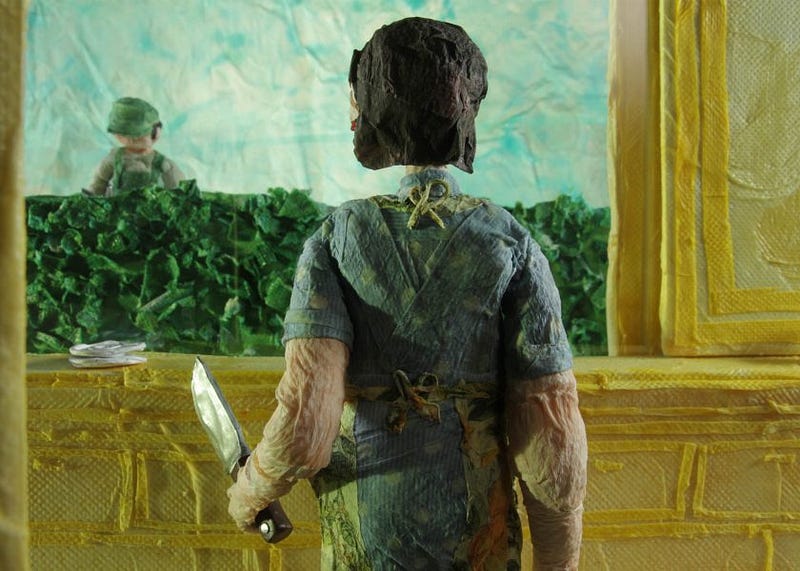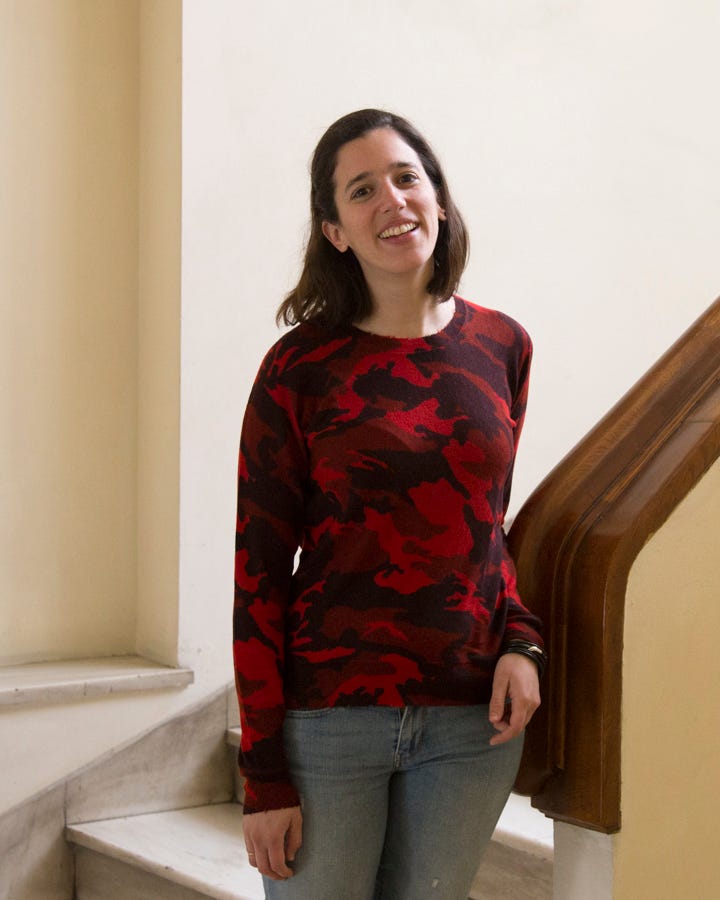29.10.2019
What Lies Below: Diving into the Animated Worlds of Eirini Vianelli
Κινουμενη εικονα
Γλώσσα πρωτότυπου κειμένου: Αγγλικά
“You’ve got to work with your mistakes until they look intended.”
— Raymond Carver, “Cathedral”

Like many artists, Eirini Vianelli did not follow a straight path to her destination. Today, she is an experimental animator whose projects include producing her own films, collaborating with theatrical pieces and operas, and even sprinkling in commercial jobs to support her vibrant artistic practice. But when she thinks back to herself as a child, she admits none of this would have seemed then like even a faint possibility: “25 years ago, I loved watching animated movies, but I had no idea that animation could be used in so many different ways. I never saw it in theatres and operas like today. I had no idea the internet was coming and that there would be such a need for content. Really, I had no idea what the future would hold — I still don’t, but now I find that exciting.” Along her once uncertain path lay many roads not taken and just as many failures that eventually, even unexpectedly, revealed the way forward. Animated films are often made up of just such stories: a plucky character setting out into the world to find themselves, facing troubles and trials along the way, before they are granted some deeper wisdom and a happy ending. I imagine that Eirini, all smiles and with a mischievous twinkle in her eye, would make a great heroine for exactly this kind of tale. But of course, she knows that the life of the artist is not as simple as that. Still, somehow, for the time being, she has made it work.
From an early age, Eirini loved to draw; while growing up, her father was a film director. In retrospect, the connecting bridge between these two passions lay right in front of her — animation! — but such clarity remained a long way off. First, Eirini went to London to study graphic design, a profession she would never practice. Fortunately, her degree program was open-minded and amenable to different ways of engaging with the field. In her final year, for example, she made a film. The family business beckoned. Back in Athens, she took up work in the industry, taking any and every kind of role she could find: production assistant, casting director, location scout, director’s assistant. Film seemed to be the answer and her desire to make a career of it took her to a summer directing program at New York University. She arrived filled with expectations of where the experience would lead.
She pauses here, and with the tense vividness of a good storyteller, brings me back. “I can still remember the feeling of an entire crew looking at me for direction, depending on me, the collected weight of expectation and responsibility. I ended up shooting a short film in 20 minutes.” She continues, able to laugh about it now, “No, not a 20-minute film: after gathering my team, I began to have an awful feeling that I was wasting everyone’s Saturday. So, just 20 minutes after we began, I called it a day; the shoot was over and I sent everyone home.” A short time later, and well before the summer course had ended, Eirini went home, feeling like a failure. But she had learned an invaluable lesson: she needed to work on her own.

Her next adventure was a self-published children’s book. Illustrating was peaceful, solitary, enjoyable even. But she soon realized that she couldn’t do everything on her own. For one thing, she is a horrible business person: this she discovered after going door-to-door to Athens’ bookstores, carrying her work on her shoulder. At one shop, for example, they were hesitating between buying five or ten books from her. She compromised by selling five and giving them two for free. Math, she noted, is also not a strong suit.
But producing the book brought her back to drawing, and then illustration, and quickly to animation. After making a music video for a friend, something seemed to click. The odd little art form seemed to have it all: combining drawing with film, a hand-made, even crafted element with more technical and precise work. Animation can be carried out simply, in two-dimensions, but Eirini frequently works with objects, crossing the line between sculpture and installation. “I began watching YouTube videos to get better, learning everything I could. But I knew I had to go further.” Again, she struck out into the world, this time for a masters degree in experimental animation from CalArts, in Los Angeles. “The school was everything I could have asked for: patient, generous, welcoming — and filled with fellow obsessives. There I found a community and even more, a feeling that I had finally found my way.” Eirini’s creative desires continue to grow and evolve, but animation has proved to be a medium adaptable to these changes, giving her the space to explore and push herself.
Her time in Los Angeles was not without its challenges though. While the first year passed idyllically — learning, talking, animating, collaborating, and with the promise of being able to surf on the Pacific any time she wanted — soon the pressure began to mount. She had come all the way from Athens to make an animated film and so as her studies drew to an end, she was driven by one thought, “It has to be perfect.” This graduation project, a short film titled Icebergs (that has gone on to win several awards at film festivals around the world), explores many themes, one of which is how we tend to take things too seriously. For Eirini, this lesson was hard-won: “Even though I was trying to convey this message, I myself took the production of the film way too seriously. After one particularly rough day of editing, I woke up to discover that I had lost hearing in one ear. I went to several doctors and no one could give me a definitive answer. In fact, I still don’t know what caused it [and her hearing still hasn’t returned]. But all of this was a shocking reminder: ‘It’s just an animated film. Relax.’ When you’re in the midst of a project, you feel it’s so important that it becomes the whole world. When it starts to go wrong, it’s like a bomb ticking down to zero. I think we would all benefit from getting a little bit of distance from our own work.”
Perhaps Eirini has learned to take some distance for another reason: she is not the only creative force behind her projects. Although she feels best when working alone, she revealed to me that she does have collaborators: the puppets that animate her films. She explains further, “First, I have a story in my head [or one she has read — Raymond Carver, for example, who opens this essay]. Then, I produce a drawing of the imagined world, one-to-one in scale with the resulting film set. After all, when I build my miniature scenes, everything has to be the right size. For example, if the door is too small for the puppet, the character won’t be able to fit into the room and I won’t be able to make an animation. But for all of my preparation, it’s only when I start physically crafting my characters that they become something else entirely.”
Some of this surprise results from the fact that Eirini is, self-admittedly, not a good sculptor. But she has turned this weakness into a strength, as her willingness to accept the difference between what she imagines and what she can actually produce leads, unexpectedly, to new ideas. As her puppets come into being, they themselves seem to have a say in how they will move, speak, and act in the scenes. Even their materiality pushes her in unexpected directions. For example, paper towel is too absorbent of the colored dyes, but when dipped in latex, it takes on the look she needs. But then the latexed paper only allows her to construct certain kinds of eyes, other kinds of mouths. Each puppet walks in a particular way, lifts their arms like so. All of these limitations reveal how each character will express themselves and their emotions. Eirini’s puppets are mysterious beings, filled with surprises, revealing themselves as part of her collective creative process. Fitting, then, that while most of the sets are thrown away after production, Eirini keeps many of her puppets — they are the objects from which her art emerges.
Eirini’s relationship to these puppets is also expressed through the themes of her work. As the title Icebergs indicates, Eirini believes we only ever see the tip of other people’s lived realities, the true ways they experience the world. Even our own innermost feelings are imperfectly accessible to us. But watching a puppet helps us realize these gaps. As she tells me, “When we see a puppet or something drawn, we distance ourselves from it. This helps us have a more sympathetic eye to them. It’s like how we are with children. Think about how understanding we are with them: if a baby is fussy, we really try to understand it, we give it so many excuses. But when a driver cuts us off, our first reaction is ‘Fuck them.’
Eirini’s interest in children must go back some time, since she wrote her first children’s book years ago. But it has deepened today, as she is now a proud mother. Thanks to her new role, she lately finds herself spending hours at the playground. But as ever, she draws creativity from what’s in front of her. In this case, observing young children at play has given her a new studio in which to gather material. She carefully notes her observations, especially the moments when children act like grownups (and grownups like kids). This frequent inversion will likely form the basis of her next film.
In the meantime, as Eirini gets to know her daughter better (another character who will surely surprise her), she continues to explore herself and her practice. She admits, “I don’t know anything about myself. Socrates’ words ‘Know thyself’ — easier said than done! Every time I think to myself, ‘I’ve got this, I’ve got it all figured out,’ is the exact moment when I realize how much is out of my control.”
Alexander Strecker is pursuing a PhD in Art, Art History and Visual Studies at Duke University. His research explores how artistic practices register the contradictions inherent in ideas of crisis, periphery, and technology, with a focus on how these tensions are felt acutely in contemporary Greece while also resonating worldwide.



